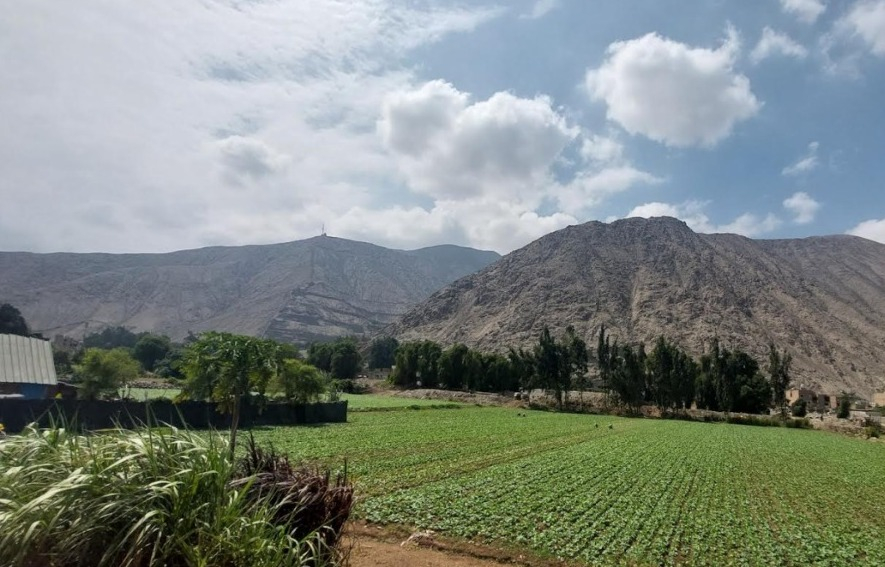
The loss of crop areas in its valleys and the progressive reduction of the agricultural workforce in Lima aggravate the food vulnerability of the Peruvian capital, which after reaching poverty peaks in 2023 can only supply 3% of its population with its own crops. , reveals a new study by the NGO Cesal, carried out in alliance with the Consortium for Health, Environment and Development (Ecosad).
The research, prepared under a MuSIASEM approach (Multiscale Integrated Analysis of Social and Ecosystem Metabolism) with the financial support of the Madrid City Council within the framework of its Sustainable Cities project, indicates that the Peruvian capital is “highly dependent” on the food supply that It comes from the interior of the country, since it only generates 3% of the food it consumes in its only three basins (Rímac, Chillón and Lurín). The remaining 97% arrive from other regions.
The study was carried out in the lower basin of the Rímac River and the lower micro-basin of the Huaycoloro River, to which are added similar studies carried out by Ecosad, together with Rikolto and the Ecological Agriculture Network (RAE), in the basins of the Lurín and Chillón, obtaining a complete analysis of the three valleys.
The permanent reduction of agricultural land is the result of high real estate speculation, zoning changes and illegal occupations, which are, among others, the main problems facing the productive valleys of Lima. Thus, in the lower basin of the Rímac River, there has been a marked reduction of 58% of total agricultural production in the district of Lurigancho.
This explains, to a large extent, the food vulnerability of Lima, where just over 30% of the country’s population lives and where poverty, according to the INEI, grew to 26.4% in 2023. Due to this deficit, the food supply is at the mercy of imports, intermediaries or at risk of road closures due to environmental problems or social conflicts. To this, we would have to add the shortage of products due to climate change, which would force the regions to reduce their shipments of products to the capital to guarantee their own supply.
Another key aspect is the decrease in the metropolis’ agricultural workforce, which is migrating to the service sector. For this reason, the number of agricultural workers in Metropolitan Lima today represents less than 1% of its employed EAP. Likewise, the study warns of an exponential increase in the use of fertilizers (90% imported) that drive up the price of food.
“A study developed by the Ministry of Development and Social Inclusion (MIDIS) reveals that food insecurity in Peru is around 50%. It is based on this diagnosis that, from the Ministry of Agrarian Development and Irrigation (Midagri), a nutritional food security policy is being worked on to strengthen our sustainable food systems and reduce this food insecurity in the population towards a period of 2050″, mentions José Luis Alarcón, specialist from the General Directorate of Agrarian Policies of Midagri.
Work with communities without intermediaries
To correct this situation, the study, unique in Lima, proposes working under a collaborative, multisectoral approach that ensures the participation of communities and adapts to the characteristics of each basin, with the aim of ensuring the sustainability of their food systems.
In the lower basins of the Chillón, Rímac and Lurín rivers there are Multi-Actor Food System Platforms, led by local institutions and made up of all the actors in the system. The study highlights that communal pots and soup kitchens are very important allies in promoting the consumption of local production in the valleys, generating healthy eating habits and preventing childhood anemia, in addition to “guaranteeing many families of limited economic resources access to food.”
“As part of the community initiatives, vertical biogardens have been implemented in common pots to promote healthy eating and self-consumption in these spaces. Direct sales are also made from the farm to the pot, which achieves the economic recovery of the producers and the pots can access healthy products at a fair price. These community initiatives can be transferred to any territory since they show results and are sustainable,” says Paola Cárdenas, coordinator of urban processes at Cesal.
It should be noted that food neighborhoods have the potential to generate healthy “food annexes” that connect producers, merchants and neighbors with short chains.
“Projects like Cesal’s are important because they manage to connect actors in the food system: producers, the municipality, academia, among others, with productive actors and carry out initiatives such as the direct sale of the farm to common pots. These types of actions seek to overcome the limitations of the food system itself,” highlighted Alain Santandreu, Executive President of the Ecosad consortium.
Source: Larepublica
Alia is a professional author and journalist, working at 247 news agency. She writes on various topics from economy news to general interest pieces, providing readers with relevant and informative content. With years of experience, she brings a unique perspective and in-depth analysis to her work.












